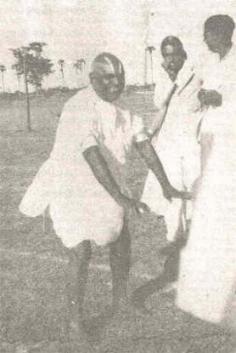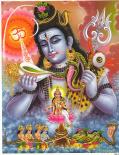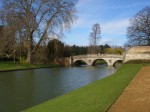
Saṅgita Pitāmaha, Padma Vibhushan Dr. Semmangudi Srinivasa Iyer
Coming to the story of how Lalitha and myself became the Sishya-s of Semmangudi Mama- for a long tome we nurtured a deep desire to learn from Mama, but were hesitant to approach him since we felt that it was “Pērāśai”.
On one of our visits, along with our Amma, Smt. Subbulakshmi Muthuswamy who was his disciple, the inevitable happened ! Amma started introducing us but before she could finish he said `Teriyumē, Lalitha – Nandini, ippa kūda radiovila ivālōḍa katchēriyai kēṭṭen, rōmba nannā vāsikara, nalla vāsippu, nalla vazhi, Katcheri illada nāllila enkita anuppu, nan āvāḷukku sollitharēn’. (I know, Lalitha and Nandini, recently I heard their concert in the Radio and was very impressed, they play very well and have a good tradition, send them to me for advanced lessons when they are free).
We were speechless, shocked beyond words…it was unbelievable (even as I re-live those moments now, it is unbelievable… what a great blessing !) ….we wanted to ask him to accept us as his Sishya-s and lo ! even before we could ask he said that he would teach us. What a blessing, this is the greatness of Mama. But we soon gathered ourselves together to thank him and say that we would be would definitely come since it was a great blessing for us. We wanted to utilize this good fortune and started lessons with Mama immediately. He started lessons with the kriti “Mahā Gaṇapathē” in the Rāgā Naṭanārayaṇi.
As his sishya-s Lalitha and I had plenty of opportunities to listen, observe and imbibe his music from close quarters. As a musician Semmangudi Mama was a towering personality. His music was “The Ultimate”….there is so much for any musician to learn from him. His music is the perfect blend of all that you aspire or seek in Karnāṭaka Saṅgītam. (No wonder he is respected by one and all as the Pitāmahā of Karṅāṭaka Saṅgītam)
For instance if we take his Rāgā Ālāpanai-s, they are filled with rāga bhāvam but yet at the same time they are innovative, replete with unexpected sancārā-s that would immediately elicit a “sabāsh” from an listener. He was a master in portraying a complete picture of the raga irrespective of whether he sang it for 3 minutes or 15 minutes. Filled with long kārvai-s as well as subtle nuances (nagāsu vēlai), they are totally mesmerizing. He would slowly build up a rāga upto a climax – which would leave one yearning for more. He was a daring innovator as well. He invested life into rāgā-s such as Shanmugapriya and Hemavati, which found a more prominent place in the Carnātic Katcheri after Mama’s handling of these ragas.
His rendering of kriti-s is an aesthetic experience by itself. His renditions were finely chiselled gems and possessed a remarkable sophistication. The sangati-s were built gradually – never more than what was necessary. Mama would always say “Saṅgatiya pōṭṭu tinikka kūḍādu”. Kritis like Agastīśvaram – Lalitha, Janani – Rītigauḷa, Amba Nīlayadakśi – Nīlāmbari, Śri Rāmam – Nārāyaṇagauḷa, Dwaitamusukhamā – Rītigauḷa, O Raṅgasāyi – Kāmbhōji , Dēva Dēva – Māyāmāḷavagauḷa et al bear his indelible stamp and have become synonymous with Mama. He has also set to tune several compositions of Sadāśiva Brahmendra, Nārāyaṇa Tīrtha. He has also set to tune Tirukkural Kriti-s.
His Niraval & Kalpana Svara-s were free flowing and bear testimony to his creative genius. I often wonder how he could have such a wide manōdharma . He maintained a structure here as well. Initially they were simple filled with kārvai-s and then slowly increased in complexity, filled with brigā-s and other niceties. His singing of the niraval in madhyamakālam is a sheer joy, perfect in every sense. His niraval for “Śyāma Krishna Sahōdari” in Amba Kāmākśi is a personal favourite of mine. His long kārvai at “Śyāma Krishna Sahōdari in tārasthāyi rishabam is simply breathtaking. His Kalpana Svaram for Janani – initially with small āvarthanam –s and gradually building up in length, using the characteristic sancara-s of rītigauḷa is so typical of his style. In the madhyamakāla svaram-s his repetitive usage of the svara-s “grs” has an electrifying effect. His niraval and kalpanasvaram for Jātarūpa in “Dēva Dēva” have always left me yearning for more. There are several other favourites of mine, but then the list would be endless 🙂
There is always a sense of proportion and balance in his concerts. Whatever he sang, whether it was a rāga ālāpanai or kriti or niraval or kalpanasvaram or tānam – he knew the right aḷavu that had to be sung. There was so much of discipline in his singing. His style was truly majestic filled with azhutam, bhāvam & shuddham – values that ought to be emulated.
I realise that this post is quite long. The next part of this post on Semmangudi Mama will contain my personal experiences with him as a Siśya. I sign off with a video of Mama singing “Teliyalēru Rāma” – Dhēnuka in his inimitable style. Enjoy 🙂



















